Trekking the Coastal Mountains of Colombia

Sierra Nevada de Santa Marta
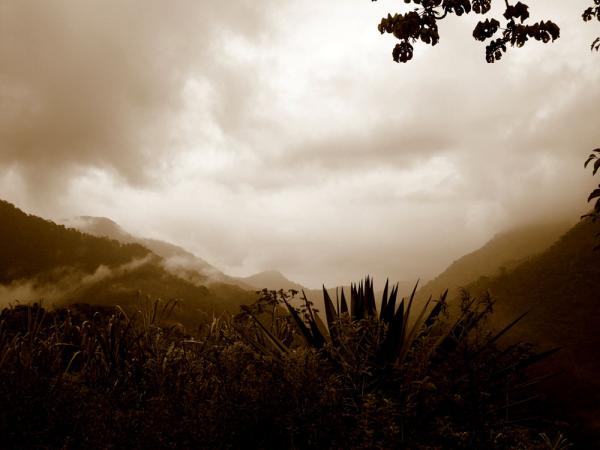
The Sierra Nevada de Santa Marta is the tallest mountain range in Colombia. Isolated from the long chain of the Andes running south like a great snake along South America, the Sierra Nevada de Santa Marta pokes its head up like an aberration at the far northern tip of the continent. Rising to 18,942 feet (more than 5,700 meters) above the blue waters of the Caribbean Sea, only 26 miles (42 kilometers) away, it is the highest coastal mountain range on Earth.
The Sierra Nevada's great elevational change, diverse ecoregions, and isolation at the edge of the continent also make it a unique mountain range geographically, biologically and culturally for people who live there. Thick misty jungles, snow capped peaks, rare and unusual creatures, ancient lost cities and isolated indigenous cultures have steeped these mountains in myth and intrigue since they were first discovered by conquering Spanish invaders. Today the Sierra Nevada de Santa Marta remains as enigmatic and mysterious as ever, reluctant to reveal hidden secrets.
Biodiversity
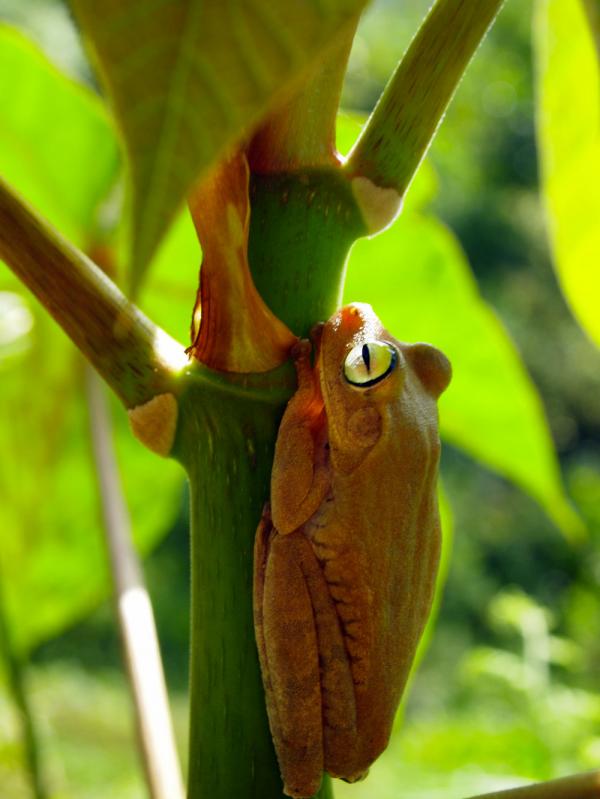
Ascending these mountains from their coastal origin takes a visitor through dry coastal forests, humid jungles, misty cloud forests, all the way up to ((CONLINK|29606|cold alpine-like pÃ
Center of the world

The Kogi, or Kogui, people are among only a handful of Pre-Columbian civilizations in the Sierra Nevada de Santa Marta whose culture and way of life survived the Spanish conquest. The Kogi regard the Sierra Nevada de Santa Marta, their homeland, as the heart of the world.
Kogi cosmology is centered heavily on their beliefs in nature. They see the Earth to be a living being made by a great creator figure, "The Great Mother," that provides guidance to the world through the balance of nature. Each Kogi community, such as this one, is closely knit around priests, called Mamos, that serve as intermediaries to the spirit world and help sustain the Earth through deep meditation and highly symbolic offerings.
Kogi culture strongly reflects the forces of duality and balance through separate, but egalitarian roles and duties between genders. This symbolic yin and yang between the creative forces of male and female permeate nearly all aspects of Kogi culture. To the Kogi, balance between these forces must be observed to reinforce the balance of harmony and creativity in the world.
The Kogi refer to non-Kogi people (Westerners) as the "younger brother." They believe the younger brother was sent away from the heart of the world long ago for damaging the Great Mother, but has returned to wreck havoc and destruction. With climate change, the shrinking of ice on sacred peaks, destruction of the forest, and slow assault on their way of life, the Kogi have many reasons to fear their legends of the younger brother will come true.
Get the world’s most fascinating discoveries delivered straight to your inbox.
The Tairona Civilization
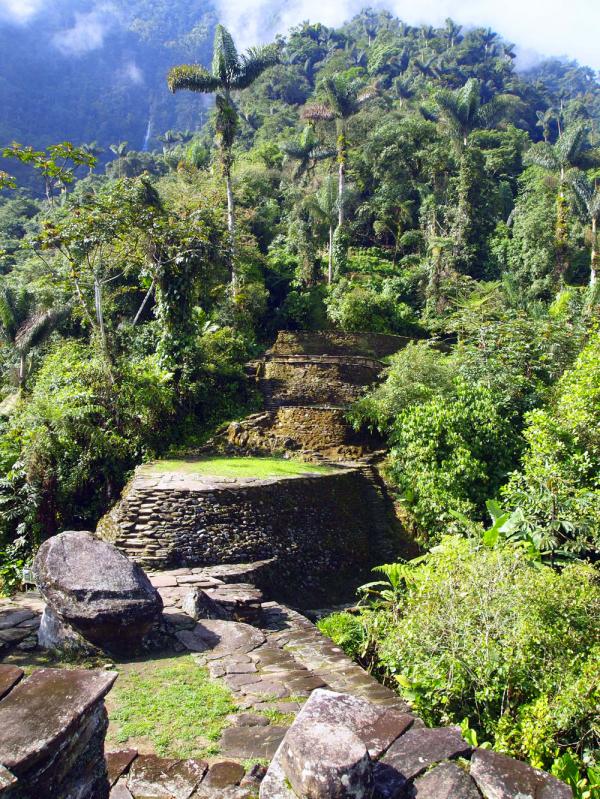
The ancestors of the Kogi before the Spanish conquest are thought to be from the ancient Tairona civilization. The Tairona were a group of chiefdoms scattered throughout the Sierra Nevada de Santa Marta and nearby areas. Knowledge of the Tairona civilization is limited by archaeological findings and written accounts from the Spanish colonial era, but some evidence shows the Tairona inhabited the coastal Sierra Nevada de Santa Marta as far back as 200 B.C.
Spanish written accounts from the 1500s report that the valleys of the Sierra Nevada were densely populated with people and that extensive crops and irrigation systems existed here comparable to those in Europe. It is believed the Tairona created a vast trading system between villages on the coast and those inland that led to the establishment of larger villages and cities like this one known as Cuidad Perdida, or the lost city, deep in the heart of the Sierra Nevada de Santa Marta.
Upon their arrival the Spanish tried to subjugate and enslave the Tairona but suffered great losses that led them to use more diplomatic means of subjugation. Eventually, bristling under economic and religious pressures from the Spanish the Tairona led a rebellion in 1599 which prompted the Spanish to hunt and kill their leaders, burn their villages, relocate and assimilate those Tairona remaining into the slave-like Encomienda system. The remaining Tairona in the Sierra Nevada de Santa Marta fled deep into the highland mountains living as cultural refugees to a once mighty civilization now lost to the jungle.
Cuidad Perdida
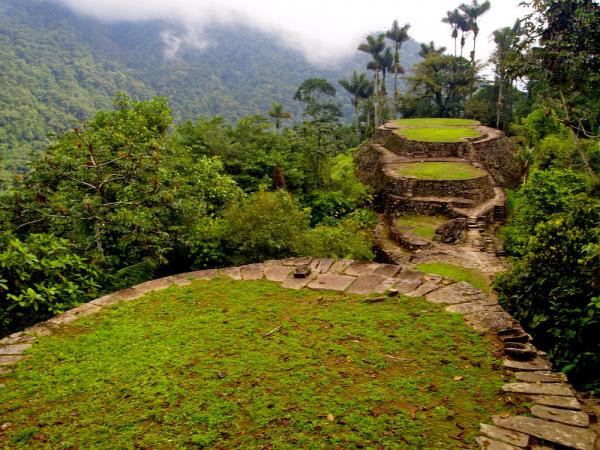
Though long known and cared for secretly by the Kogi and other tribes, in 1972 looters discovered the remains of a major archaeological site deep in the jungle mountains. This site, known as Cuidad Perdida, the lost city, is probably the most fascinating and best-known Tairona archaeological site in the Sierra Nevada de Santa Marta. After a conflict-ridden history first between looters and the government and later with revolutionary guerillas and paramilitaries, the site is now under the care of the Colombian Institute of Anthropology and History, which continues to unravel the secrets of this enigmatic "lost city" deep in the Sierra Nevada de Santa Marta.
Studies of the site suggest that it was established around A.D. 800 At over 32 acres (13 hectares) the city supported somewhere between 1,500 to 2,400 people. Over 184 round houses have been found terraced into the mountainside and connected by a spider web of stone walkways and stairs. To enter the city a visitor must climb over 1,200 near vertical stone steps up the mountainside through thick jungle. Needless to say, arriving at the lost city drenched in sweat after a grueling three-day hike to overlook the jungle from the top of these ancient ruins is nothing short of spectacular.
Other Tairona "lost cities" are widely thought to exist in the Sierra Nevada de Santa Marta, still as yet hidden and undiscovered by the outside world.
The jungle

Recognizing the tremendous biological and cultural wealth of the Sierra Nevada de Santa Marta, several local, national and international organizations have taken an interest in conserving these lands for wildlife and indigenous peoples. The Colombian government recently declared much of these mountains a part of the Sierra Nevada de Santa Marta Biosphere Reserve and National Park to conserve the plants and animals found here and protect ecosystem services like fresh water. The river basins that drain from the Sierra Nevada provide fresh water to over 1.2 million people.
Local conservation organizations in partnership with international groups like The Nature Conservancy are actively involved in conservation efforts in the Sierra Nevada de Santa Marta today. Ecological assessments and programs that return lands and promote agro-ecological farming help empower indigenous groups like the Kogi, who have been stewards and protectors of this land for centuries.
Found no-where else
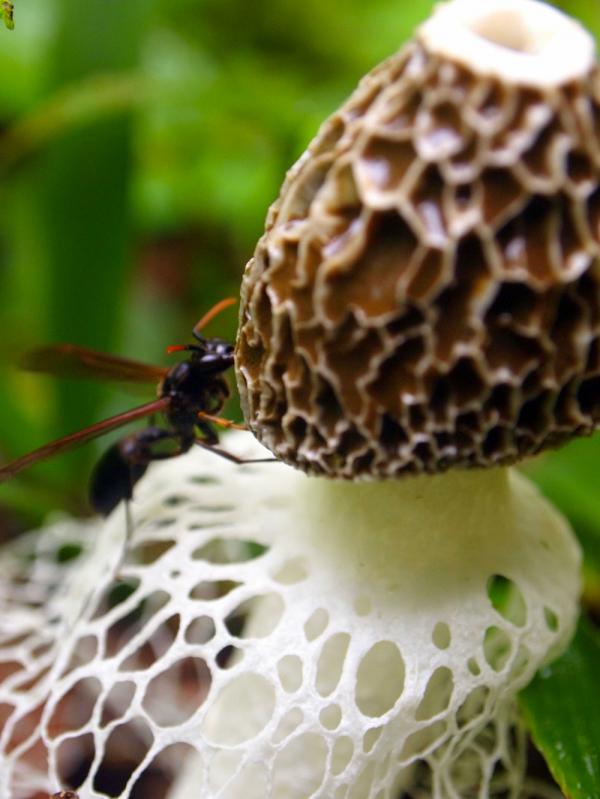
Many conservation groups have taken such a great interest in conserving the Sierra Nevada de Santa Marta because the mosaic of habitats and species found here are like nowhere else on Earth. Separated from the Andes chain by plains and deserts, the Sierra Nevada is a self-contained microcosm of diverse ecoregions and lifeforms within a relatively small area. This geographic isolation has allowed some plant and animal species to evolve here separated from other populations, sometimes leading to entirely new species. Many such species in the Sierra Nevada de Santa Marta are endemic and found nowhere else in the world.
Slogging through the jungle on a muddy trail, a thoughtful visitor may come across innumerable biological mysteries, like this wasp curiously attracted to the flamboyant fruiting body of this mushroom. Many of the species and ecological complexities that exist here still remain unknown to science.
The campo
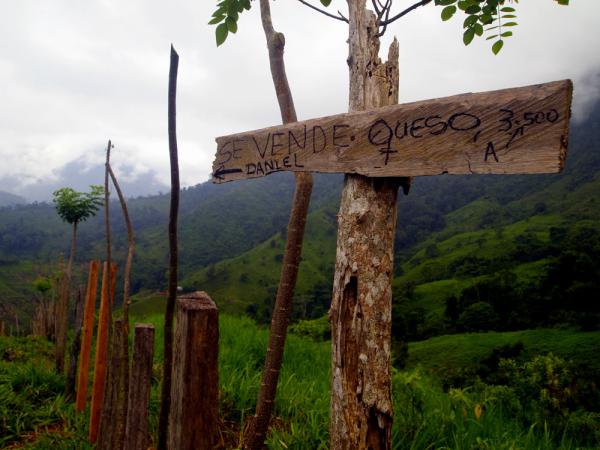
Before science can begin to unravel many of the mysteries of this place though, those mysteries could disappear. Clearing of the forest slopes by colonists seeking land pushes the agricultural frontier deeper and deeper into the Sierra Nevada de Santa Marta yearly. Many newly created farms line the trails leading to the jungle where crops are now sown and dairy cattle graze on hillsides once blanketed in forests. Rudimentary signs like this one advertising local cheese for sale are a telltale reminder of the process of change the Sierra Nevada de Santa Marta is currently experiencing.
Cultivation of illegal coca crops for the drug trade also contributes to the destruction of these forests. The erosion caused by this deforestation also chokes the rivers and streams in silt. Together, agricultural expansion and coca cultivation have helped contribute to the destruction of over 72 percent of the Sierra Nevada's original forests.
Mountain streams to jungle marshes

The rain that falls in the high mist-shrouded peaks of the Sierra Nevada de Santa Marta all eventually finds its way to the Caribbean Sea . Fast and narrow highland streams swell and grow to deep muddy rivers and estuaries as all waters finally fan out to the sea. Here in Tayrona National Park on the coastal rim of the Sierra Nevada de Santa Marta, the vegetation changes from thick montane forest to marshy reed beds, sandy soils and swaying palm trees.
Tayrona National Park extends over 93 miles (150 kilometers) squashed in a sandy embrace between the Sierra Nevada de Santa Marta to the South and the deep blue waters of the Caribbean stretching North to the horizon. This oasis between mountains and sea is awash in life. Over 108 mammals can be found here and at least 300 species of birds, like this Great Egret (Ardea alba).
Mountains, jungle and sea
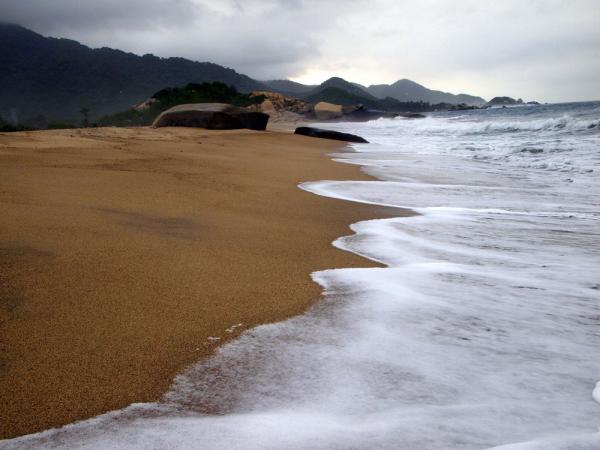
Eventually the great Sierra Nevada de Santa Marta marches off beyond the waves and is swallowed up by the sea. Here the jungle hills taper off to sand, leaving behind huge wind sculpted boulders lying on the beach as if washed up by the surf. At this meeting place of land and sea the ancient forces of weathering and erosion that have sculpted this landscape for millennia continue to do battle, slowly grinding these mountains back into sand.
Arriving at the coastal limit of the Sierra Nevada de Santa Marta is the logical endpoint of a journey spanning jungle, mountain and sea. Walking along the surf line a salt haze hangs in the warm air and palm trees rustle like wind chimes to the rhythmic pounding of the Caribbean waves. Poised on the rim of the Sierra Nevada at the top of South America with a feral beach to oneself feels nothing short of magical, forgotten and tinged with an air of discovery.


